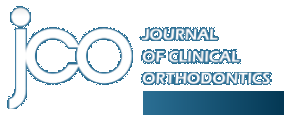Search Results For: 'case report'
1861.
The T-Control Philosophy and Prescription for Passive Self-Ligating Brackets
Volume 54 : Number 3 : Page 159 : Mar 2021
Drs. Tocoloni, Topolski, Moro, and Correr introduce a bidimensional prescription with customized torque and angulation values for the anterior, buccal, and posterior archwire segments. Their seven-step T-Control philosophy is illustrated by the case of a Class III patient.
1862.
Bio-Progressive Therapy, Part 2: Principles
Volume 11 : Number 10 : Page 661 : Oct 1977
(CONTINUED FROM PART 1) The clinician needs to base his treatment mechanics on the results he wants to achieve with the goals and objectives he has in mind. He then should select the mechanical proced...
1863.
Directional Edgewise Orthodontic Approach, Part 1
Volume 8 : Number 11 : Page 617 : Nov 1974
Edgewise orthodontics has been thought of as a complicated, highly technical, exacting technique. This is unfortunate. It really doesn't have to be that way. I feel that a lot of good people have been...
1864.
Prevention of Relapse in Surgical-Orthodontic Treatment, Part 2: Maxillary Superior Repositioning
Volume 21 : Number 1 : Page 0 : Jan 1987
Presurgical Orthodontic Treatment Properly use vertical mechanics. Inappropriate use of vertical mechanics is almost exclusively related to attempted orthodontic closure of open bite by extruding ante...
1865.
The Eureka Spring: A New Interarch Force Delivery System
Volume 31 : Number 7 : Page 454 : Jul 1997
Before the introduction of extraoral force by Kloehn in the 1950s,1,2 interarch force was used extensively in the treatment of Class II and Class III malocclusions.3 For the next 25 years, however, ma...
1866.
THE READERS' CORNER
Volume 39 : Number 6 : Page 363 : Jun 2005
How have you learned about skeletal anchorage? Many respondents reported more than one way of acquiring knowledge about skeletal anchorage. A substantial majority (83%), however, learned about skeleta...
1867.
Volume 42 : Number 9 : Page 0 : Sep 2008
Last year, a JCO Readers' Corner found that only 25% of a small sample of respondents were currently using miniscrews in their practices, and many fewer were placing the screws themselves.1 By now, ho...
1868.
Planning Oral Surgery: New Methods of Communication
Volume 11 : Number 6 : Page 413 : Jun 1977
Because oral surgery is a team effort, there is an increased need for communication. When surgery is to be performed, the patient's desire for (and his right to) information is greatly increased over ...
1869.
The Abuse of Extraoral Anchorage
Volume 11 : Number 7 : Page 483 : Jul 1977
Proper integration of extraoral traction into the orthodontic treatment plan is of utmost importance. Since extraoral orthopedic force can have an effect upon the facial skeleton, this has allowed us ...
1870.
Movement of Ankylosed Permanent Teeth with a Distraction Device
Volume 38 : Number 11 : Page 612 : Nov 2004
An ankylosed permanent tooth, one of the most challenging problems in dentistry, almost always has a poor prognosis.1-5 Treatment usually requires block surgery, repetitive luxation, or extraction of ...
1871.
THE READERS' CORNER
Volume 54 : Number 4 : Page 241 : Apr 2020
JCO readers discuss a wide range of orthodontic insurance issues, including patient coverage, preauthorization requirements, PPOs and HMOs, state regulations, and staff management. Individual comments address common frustrations and specific recommendations.
1872.
Constructing the Gnathologic Setup and Positioner
Volume 14 : Number 2 : Page 121 : Feb 1980
In previous JCO articles, I described the importance of a gnathologic tooth positioner (July, 1975), adult orthodontics and how knowledge of occlusion can effect adult treatment (July, 1976), and last...
1873.
Computerized Paperwork in the Orthodontic Office
Volume 15 : Number 12 : Page 825 : Dec 1981
I want to share my experience in developing a data processing system to computerize orthodontic paperwork. Unsuccessful attempts to use a computer for this purpose have resulted in a negative attitude...
1874.
PEARLS
Volume 29 : Number 11 : Page 629 : Nov 1996
Several years ago, I decided that I did not want to spend the rest of my professional career in a high-volume orthodontic practice, with limited time for talking to patients and parents. I therefore m...
1875.
MARKETING & REFERRAL MANAGEMENT
Volume 1 : Number 10 : Page 96 : Aug 2019
Two articles take you into the mindset not only of the patient considering a choice of practices, but of the pediatric dentist deciding whether to refer to a specific orthodontist. Longoria’s “Factors...
1876.
Volume 12 : Number 11 : Page 761 : Nov 1978
DR. BRANDT Sealants are a controversial area. Do you feel sealants add a positive element to bonding? Are you convinced sealants are essential? DR. ZACHRISSON My preference for using sealants evolve...
1877.
JPO Interviews Dr. Irving D. Buchin
Volume 1 : Number 2 : Page 62 : Oct 1967
62-jco-img-0.jpgIrving Buchin is one of the world's most respected clinical orthodontists. He is an Instructor at the Tweed Foundation and Associate Professor of Orthodontics at the Boston University ...
1878.
Prevention of Relapse in Surgical-Orthodontic Treatment Part 1 Mandibular Procedures
Volume 20 : Number 12 : Page 0 : Dec 1986
Factors that affect the stability of combined orthodontic and surgical treatment vary according to the specific dentofacial deformity being corrected. However, there are usually four basic stages of t...
1879.
Volume 5 : Number 11 : Page 597 : Nov 1971
The Case The case presented 10/8/60, a seven-year-old boy with a Class I malocclusion (Fig. 1). The immediate problem was severe crowding in the lower anterior region. The permanent lower central inci...
1880.
Volume 54 : Number 12 : Page 746 : Dec 2020
Dr. Ruíz-Mora and colleagues illustrate a four-step approach for eruption of bilateral impacted upper canines associated with severe incisor root resorption, using a customized palatal anchorage device and transalveolar nickel titanium closed-coil springs. Two adult case examples are provided.
Showing 1861-1880 of 3241 results. Search completed in 0.143 seconds.

